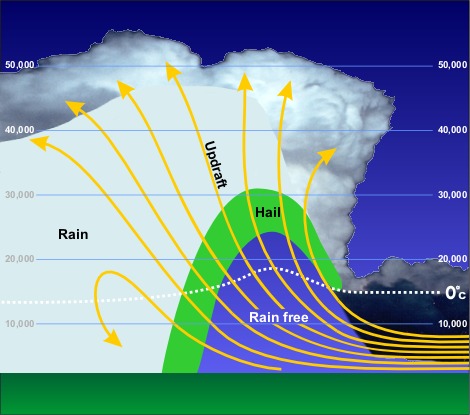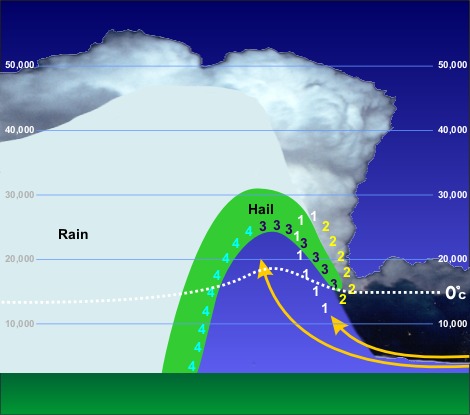
Hail is precipitation that is formed when updrafts in thunderstorms carry raindrops upward into extremely cold areas of the atmosphere. Hail can damage aircraft, homes and cars, and can be deadly to livestock and people. One of the people killed during the March 28, 2000, tornado in Fort Worth was killed when struck by grapefruit-size hail.
While Florida has the most thunderstorms, New Mexico, Colorado, and Wyoming usually have the most hail storms. Why? The freezing level in the Florida thunderstorms is so high, the hail often melts before reaching the ground.
Hailstones grow by collision with supercooled water drops (Supercooled drops are liquid drops surrounded by air that is below freezing, which is a common occurrence in thunderstorms). There are two methods by which the hailstone grows, wet growth and dry growth, and which produce the "layered look" of hail.
In wet growth, the hailstone nucleus (a tiny piece of ice) is in a region where the air temperature is just below freezing, not super cold. Upon colliding with a supercooled drop, the water does not immediately freeze around the nucleus.

Instead, liquid water spreads across tumbling hailstones and slowly freezes. Since the process is slow, air bubbles can escape, resulting in a layer of clear ice.
With dry growth, the air temperature is well below freezing, and the water droplet immediately freezes as it collides with the nucleus. The air bubbles are "frozen" in place, leaving cloudy ice.
Strong updrafts create a rain-free area in supercell thunderstorms. Meteorologists call this area a WER, which stands for "weak echo region".
This term WER comes from an apparently rain free region of a thunderstorm which is bounded on one side AND above by very intense precipitation, indicated by a strong echo on radar.
This rain-free region is produced by the updraft and is what suspends rain and hail aloft, producing the strong radar echo (see images above/right).
- The hail nucleus, buoyed by the updraft, is carried aloft and begins to grow in size as it collides with supercooled raindrops and other small pieces of hail.
- Sometimes the hailstone is blown out of the main updraft and begins to fall to Earth. A strong enough updraft may result in hail being projected out ahead of the thunderstorm or main precipitation core.
- Other times, the updraft will catch the hailstone and move it back into the cloud, where it once again collides with water and grows; this process may be repeated several times.
- When the hailstone can no longer be supported by the updraft, it falls to the Earth. The stronger the updraft, the larger the hailstones that can be produced by the thunderstorm.
Multi-cell thunderstorms produce many hail storms but usually not the largest hailstones because the mature stage in the life cycle of the multi-cell is relatively short, which decreases the time for growth.
However, the sustained updraft in supercell thunderstorms support large hail formation by repeatedly lifting the hailstones into the very cold air at the top of the thunderstorm cloud.
How strong does the updraft need to be for the various sizes of hail? The table below provides the approximate speed for each size.
Learning Lesson: Updrafts in Action
| Hailstone size | Measurement | Updraft Speed | ||
|---|---|---|---|---|
| in. | cm. | mph | km/h | |
| bb | < 1/4 | < 0.64 | < 24 | < 39 |
| pea | 1/4 | 0.64 | 24 | 39 |
| marble | 1/2 | 1.3 | 35 | 56 |
| dime | 7/10 | 1.8 | 38 | 61 |
| penny | 3/4 | 1.9 | 40 | 64 |
| nickel | 7/8 | 2.2 | 46 | 74 |
| quarter | 1 | 2.5 | 49 | 79 |
| half dollar | 1 1/4 | 3.2 | 54 | 87 |
| walnut | 1 1/2 | 3.8 | 60 | 97 |
| golf ball | 1 3/4 | 4.4 | 64 | 103 |
| hen egg | 2 | 5.1 | 69 | 111 |
| tennis ball | 2 1/2 | 6.4 | 77 | 124 |
| baseball | 2 3/4 | 7.0 | 81 | 130 |
| tea cup | 3 | 7.6 | 84 | 135 |
| grapefruit | 4 | 10.1 | 98 | 158 |
| softball | 4 1/2 | 11.4 | 103 | 166 |


